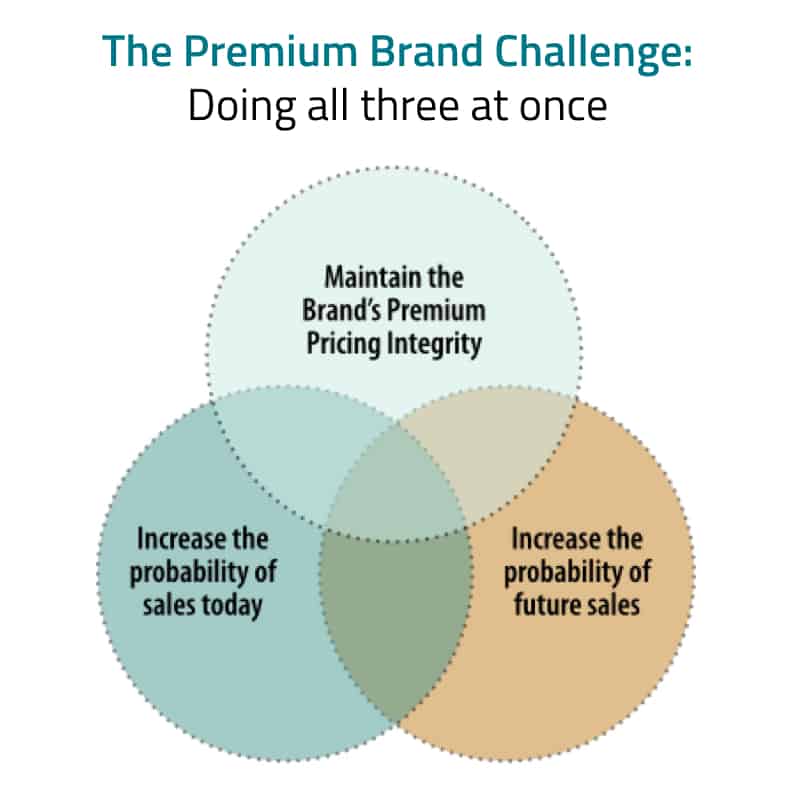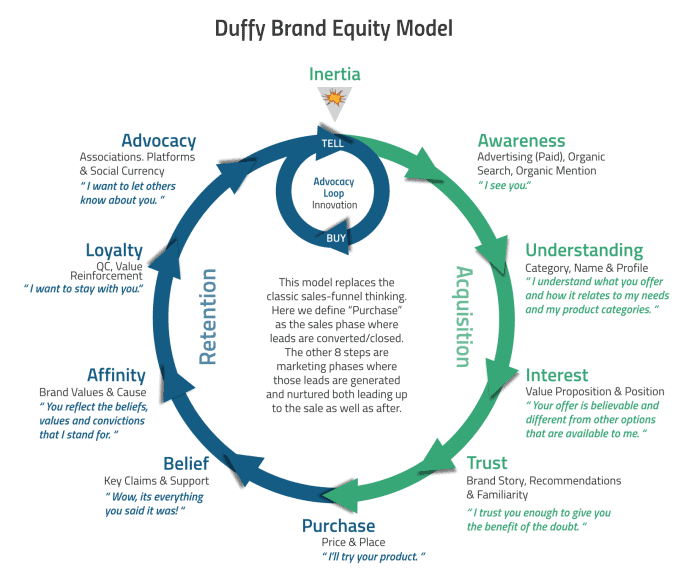Before looking into how to help our brands compete better online, it may be worth considering why we’re competing online in the first place. To many, the easy answer is to increase revenue. And, of course, revenue is vitally important since it is what ensures adequate cash flow to keep the business running.
But sustained profit margins and shareholder value come from a different metric: brand equity. A quick survey of the models for assessing brand equity reveal a heap of options. We’ve found most of these models are either too complex for practical use or are more retrospective tools rather than forward planning tools.

At Duffy Agency, we have developed a consumer-based brand equity model that, by comparison, is easy to understand and use for planning and assessing marketing activities. This model is not based on financial valuation or product attributes. It’s based on the conditions that must be satisfied to increase the probability of future purchases at a premium price point by a defined group of consumers.
That is, the likelihood of being able to generate future sales and profit by virtue of the brand’s name appearing on the product. For Duffy Agency, the only aim of online marketing (or any marketing for that matter) is to develop brand equity as defined by the model.
Consider this model as an evolution of the classic sales funnel. The sales funnel models a consumer relation that begins with awareness and terminates in a sale. Our brand equity cycle includes sales as a vital part of the equation, but it is just one of several steps required to build a sustainable business of ever-increasing value.

Our model defines brand equity in the ten stages of development that a brand’s audience passes through from consumer inertia to advocacy. These stages form our strategic framework. The value of each member of a brand’s audience varies depending on where they are in the cycle (with Advocates being the most valued). The goal is to move people through these stages as seamlessly as possible with the end-goal of converting more of them into loyal and vocal brand advocates than your competitors do.
Let’s use the example of a fictitious crayon brand named “Wipe Away” to describe the different stages a prospect would move through.
Inertia
The prospect has a relevant want or need but is not aware of the brand.
Example — “I want my little Jimmy to draw, but my problem is that he scribbles all over the walls and I have no idea how to deal with that.”
Awareness
The prospect is exposed to the brand and it registers with them.
Example — “I saw the Wipe Away logo, but I don’t know what it is. Something to do with kids I think.”
Understanding
The prospect understands what category of product the brand stands for.
Example — “I get it, Wipe Aways is a children’s crayon brand. But I already buy Crayola for little Jimmy.”
Interest
The prospect is able to differentiate your brand from others in the category based on a value proposition that is relevant and believable to them at that moment.
Example — “Interesting: Wipe Away crayons are water soluble so they wash off easy, especially from walls”.
Trust
The prospect trusts the brand enough to give it the benefit of the doubt.
Example — “I was wondering if they were safe and worked well, but then I read some positive reviews on a Mommy Blog and saw that my friend Sally recommended them on Facebook. Wipe Aways are probably okay.”
Trial
The prospect purchases the product.
Example — “They’re at Walmart and cost about the same as normal crayons, so I’m going to buy a pack for little Jimmy.”
Belief
Based on their experience with the product, the prospect concludes that the brand delivered on its value proposition.
Example — “Wow, Wipe Aways really work as promised! They wiped right off the wall.”
Affinity
The prospect is receptive to looking for reasons to like the brand and concludes that the brand shares many of their beliefs, values, and convictions.
Example — “This brand really gets me. They are into education, child safety, and the arts just like me. We have a lot in common.”
Loyalty
The prospect becomes a customer and stops actively looking for other solutions because they are satisfied that the brand delivers the best value in the category.
Example — “From now on, these are the crayons for me.”
Advocacy
The customer wants to be associated with the brand and is prone to tell others about the brand.
Example — “I’m posting little Jimmy’s wall drawings on Wipe Away’s gallery site and sharing them with my friends on Twitter and Facebook.”
The end game is to keep brand advocates in orbit around the brand with constant innovation. At any moment in time, your target market will be spread across the different stages from inertia to advocacy. The marketer’s job is to manage product, price, place, and promotion in such a way that attracts as many of the target prospects as possible into the cycle and effectively converts them into brand advocates.
Brands and brand theory can be pretty nebulous. This model has provided us with a consumer-based vocabulary to speak about, plan, and measure brand performance in concrete terms. So when we talk about brand management at Duffy Agency, we are talking about managing these ten elements and facilitating the prospect’s journey through these stages to brand advocacy. If a marketing activity is not directly contributing to this cycle, then there is a good reason it should be axed.
Check out also how to define a competitive brand position. Read more on our blog!




